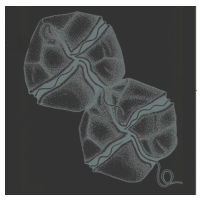“Unprecedented” Toxic Algal Bloom Closing Fisheries on the West Coast
 Algal bloom’s Phytoplankton Pseudo-Nitschia
Algal bloom’s Phytoplankton Pseudo-Nitschia
Toxic algae season has come early to the West Coast, from Monterey Bay to Homer, Alaska.
Shellfish fisheries have been shut down by the largest algal bloom in more than a decade, according to the National Oceanic and Atmospheric Administration (NOAA). It’s not unusual to see patches of algal bloom in the Spring, but this size and concentration is unusual and disruptive of normal marine life patterns.
“This is unprecedented in terms of the extent and magnitude of this harmful algal bloom and the warm water conditions we’re seeing offshore,” according to Vera Trainer, manager of the Marine Microbes and Toxins Program at the Northwest Fisheries Science Center (NWFSC) in Seattle.
The algae produce toxins which are ingested by feeding shellfish, sardines, anchovies and other plankton-loving fish. NOAA said in a release this week that it found “some of the highest concentrations of the natural toxin domoic acid ever observed in Monterey Bay and off the Central Coast of Oregon.”
California consumers have been warned not to eat “recreationally harvested mussels and clams, commercially or recreationally caught anchovy and sardines, or the internal organs of commercially or recreationally caught crab taken from Monterey and Santa Cruz counties.”
Oregon officials have stopped the harvesting of shellfish from the Columbia River south to Tillamook Head. The entire state coastline and all Washington beaches are closed to razor clamming. Commercial Dungeness crab fisheries have been closed along half of Washington’s coast.
Although humans aren’t always great at heeding warnings, marine animals are worse. They eat the things that eat the algae, and don’t fare well.
“It has really disruptive impacts to the ecosystems,” University of California, Santa Cruz, Professor Raphael Kudela told ThinkProgress. “The sea lions and the birds don’t pay attention to the warnings, so they’re the ones that are really being impacted. It’s much more a wildlife concern at the moment than a human health concern.”
NOAA beefed up an already-scheduled three-month research project to survey fisheries―begun this week―with scientists to “examine levels of marine toxins and the organisms that produce them.”
As usual, the go-to explanation for nature’s aberration is climate change. A 1,000-square-mile blob of warm water, 4-7 degrees warmer than usual, has been on scientists’ Pacific radar since 2013 and linked to changing precipitation patterns.
Warm waters are also linked to an invasion of tiny red tuna crabs (Pleuroncodes planipes) along the Southern California coast. They haven’t been seen for decades, but millions have been stranded on beaches between San Diego and Newport Beach.
Back up north, weird purple blobs have been washing up on shore. They are sea hares (Aplysia californica), a kind of sea slug, that checks in at around 30 inches in length and weighs around 15 pounds or more. They are kind of gross, but apparently harmless plant eaters.
“We're seeing more of these kinds of warming events, and I suspect it may be part of long-term global change,” Terry Gosliner, senior curator at the California Academy of Sciences in San Francisco, told the Contra Costa Times. “These are signals.”
–Ken Broder
To Learn More:
NOAA Fisheries Mobilizes to Gauge Unprecedented West Coast Toxic Algal Bloom (National Oceanic and Atmospheric Administration)
Biggest-Ever Toxic Algal Bloom Hits West Coast, Shutting Down Shellfish Industries (by Tom Hallman Jr., The Oregonian)
Huge Toxic Algal Bloom Shuts Down West Coast Fisheries (by Natasha Geiling, ThinkProgress)
Red Crabs Swarm Southern California, Linked to “Warm Blob” in Pacific (by Jason Samenow, Washington Post)
Invasion of the Blob? Giant Purple Sea Slugs Slime East Bay Beaches (by Denis Cuff, Contra Costa Times)
Harmful Algal Bloom Research in California (National Centers for Coastal Ocean Science) (pdf)
- Top Stories
- Controversies
- Where is the Money Going?
- California and the Nation
- Appointments and Resignations
- Unusual News
- Latest News
- California Forbids U.S. Immigration Agents from Pretending to be Police
- California Lawmakers Urged to Strip “Self-Dealing” Tax Board of Its Duties
- Big Oil’s Grip on California
- Santa Cruz Police See Homeland Security Betrayal in Use of Gang Roundup as Cover for Immigration Raid
- Oil Companies Face Deadline to Stop Polluting California Groundwater





